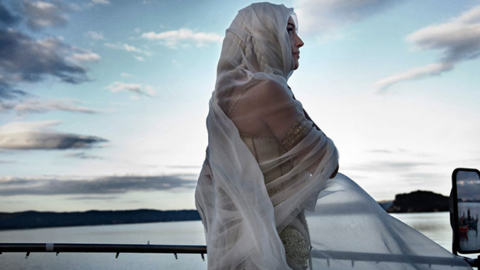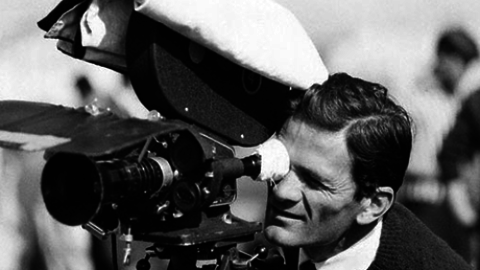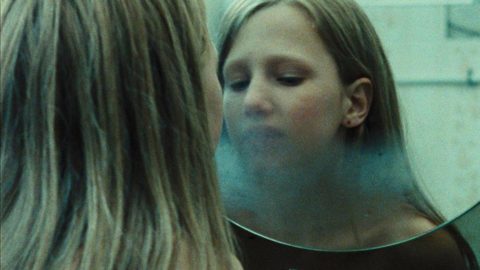Film of the Week: Happy as Lazzaro
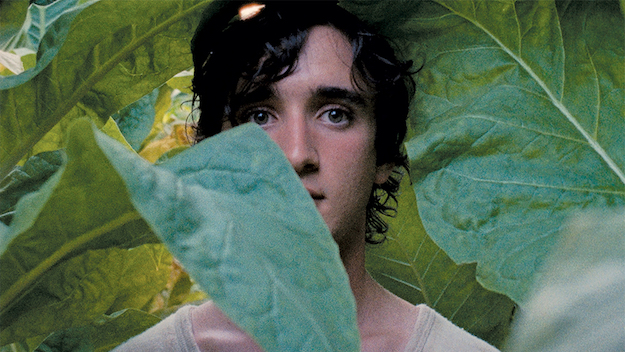
The last film by Italian writer-director Alice Rohrwacher was called The Wonders—but with her follow-up, she’s truly produced a wonder, one that confounds understanding marvelously. Her second feature, The Wonders confirmed Rohrwacher as a genuine poet of bucolic intimacy, with its heightened, part-autobiographical evocation of a childhood spent as the daughter of a back-to-the-land beekeeping family. The world of that film exuded its own charmed strangeness and didn’t really need the glittering spectacle of Monica Bellucci as a fairy-like TV star to ensure its otherworldliness. Rohrwacher’s latest film, by contrast, is hugely artificial and yet has a dream-like character that feels absolutely organic. Happy as Lazzaro has the quality of hallucination, of fable, of folk tale—while being absolutely modern and rooted, however obliquely, in the contemporary real. It’s so traditional that it feels decades old, at the very least, yet it’s one of the freshest films of the year.
It’s set somewhere in Italy, in a distant fold of somewhat lunar-seeming land dominated by thorn-covered hills and deep ravines, where the nights resonate to the sound of distant wolves—or perhaps just one wolf, which appears to have a legendary status among locals. These are the inhabitants of a secluded village named Inviolata (“Unspoiled”), and we first meet them at night, families crowded into a house to celebrate a young woman’s eager suitor serenading her with song and bagpipes. The boy playing the pipes, like a kind of resident faun, is Lazzaro (newcomer Adriano Tardiolo), a gauche creature with dark, saucer-like candid eyes, and a habit of standing alone, “staring into the void,” as the villagers put it.
He may be left out at night to guard the chickens alone while everyone else celebrates, but Lazzaro seems hardly to mind, waking up with the beatific smile of a saint in a mediaeval fresco. He may be a holy fool—but he’s a fool among the fooled. We spend the film’s first 20 minutes or so wondering exactly when the story is set: this might easily be the Italian countryside in the 1920s or ’30s or even, at moments, some previous century. With those headscarves and bagpipes, this could be the historical rural realism of Ermanno Olmi or the Tavianis. But that was a ’70s car in the first shot, wasn’t it? And before long, things are further confused by the sight and sound of a Sony Walkman pumping out ’90s Euro-pop. Even as we get to know the crowd of villagers—a whole crowd of men, women, children, laughing adolescents—and see them at what appears to be traditional fieldwork, Rohrwacher keeps us puzzling over the where, when, and why of it all. The “why” includes the fact that they’re dependent on a man named Nicola (Natalino Balasso), who doles out the few, closely coveted light bulbs they possess.
Eventually, the truth emerges: the villagers all work for a cynical exploiter, the Marchesa (Nicoletta Braschi, best known as muse and straight woman to Roberto Benigni), who lives in the grand villa on the hill, and who has been employing them as unpaid labor to harvest tobacco for her, with Nicola as the steward keeping them in line. She’s using them, in fact, as sharecroppers—a practice which only ended in Italy in the early ’80s—and has been able to keep them in the dark as a result of floods cutting off this terrain years before. “Human beings are animals,” she explains to her circle. “Set them free and they realize they’re slaves, locked in their own misery.” Besides, she says, the villagers are exploiters, too: what she does to them, they do to Lazzaro, their workhorse.
But Lazzaro doesn’t realize he’s being put upon, even when he meets the Marchesa’s spoiled teenage son Tancredi (Luca Chikovani), who adopts the dazzled peasant as his “half-brother” (Tancredi imagines his womanizing dad exercising droit de seigneur on Lazzaro’s mother, although the boy has no idea who his parents even are). The blasé Tancredi lures Lazzaro away from his work and pretends to have been kidnapped by him, so as to rebel against his mother, and ideally screw some cash out of her. The plan goes wrong, but not in the way we might expect. The sound of a helicopter overhead—the outside world breaking in, signaled by some ominously incongruous aerial shots—has a dramatic effect on the course of events. What suddenly happens to Lazzaro here, in a single dramatic shot, makes you gasp, and changes the course of the whole film—and its very nature.
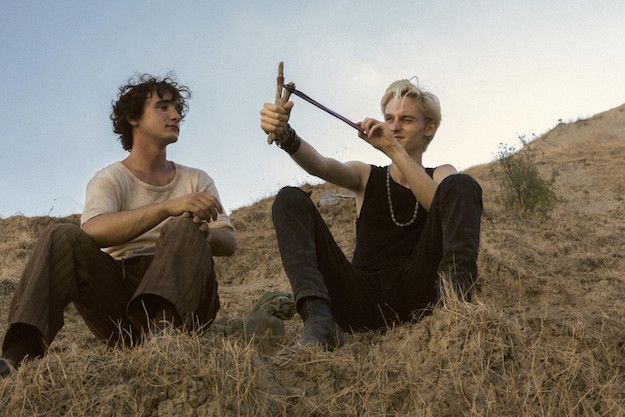
Read no further if you want to save the surprise for yourself. Lazzaro (the Italian version of “Lazarus”) lives up to his name, and is born again halfway through the film—if he’s ever been dead, that is. Indeed, in the second half, he’s probably the most vividly alive of any of the characters, who are now holding on to whatever shabby remnants of a life they’ve been left with by brute reality: they have all aged 20 years or more, while Lazzaro is still the fresh-faced, innocently handsome man-boy he always was. He returns to the Marchesa’s villa to find it deserted and overgrown with creepers, like the Sleeping Beauty’s castle, while he—like Beauty, or Rip Van Winkle—has unknowingly woken decades ahead. There’s a lovely bit of comedy with two thieves he meets in the villa—one of them the now grown-up Pippo, the son of Lazzaro’s friend Antonia, a young single mother who was the Marchesa’s maid (played as a girl by Agnese Graziani, and later by the director’s sister and lead in The Wonders, Alba Rohrwacher). The other, Ultimo—the affably bear-like Spanish actor Sergi López—is adoptive paterfamilias to Antonia’s family, now exiled in a bleak, run-down city and living together crammed in a tin-can–like roadside silo, like characters in a Roald Dahl children’s book.
What eventually happens to Lazzaro in the city is, you can probably imagine, poignant to say the least. It also carries strange echoes of Pasolini, especially given the way that the sound of Baroque church organ eerily follows Lazzaro around. The film’s urban landscape is at once intensely concrete and entirely imaginary, foreign to any solid parameters of space and time: leaving his village, Lazzaro is simply directed to walk to “the city,” which he does, in a straight line, suddenly passing through a snowy winter, seasons passing with magical illogicality. Italy itself becomes a sort of dreamed non-place: at times, like the sparely desolate geography of Fellini’s La Strada (the name of whose heroine, Gelsomina, Rohrwacher borrowed for The Wonders). Rural or urban, ancient or modern, it may be a vast expanse of railway sidings, shopping malls, motorway service areas, collapsed bridges and abandoned palazzi; but it’s still essentially the world of Carlo Collodi’s Pinocchio, in which a wandering innocent is highly likely to run foul of thieves and wolves, or perhaps be saved by them.
Rohrwacher reportedly based her story on a real-life case of rural exploitation, and her film comes across at once as an enigmatic modern folk fable and as a critique of an Italy that has abandoned those that sustain its rural economy and sold them a mess of media pottage. Where the family of The Wonders were seduced by a TV show wanting to make “trophy rurals” out of them, the exiles from Inviolata (eventually violated by the very social system that proposed to free them) huddle in front of a screen showing the kind of variety show that’s long been considered the epitome of televisual pulp.
There are genuine moments of magic in Lazzaro, all analog, you might say, and extremely simple: one of them a lovely editing trick that has Lazzaro seeing his old friends as they were in the past, then as they have become. Little hints of the supernatural, or perhaps just of folk comedy, include the villagers’ power to whip up a wind by blowing, or the way that the music in a church abandons its organ to follow Lazzaro.
And then there’s the magic of the performances: the unruly bustle of the ensemble at Inviolata, from small kids to a wrinkled, almost mummy-like nonna; Lopez’s bemused gruffness; the spiky energy of Alba Rohrwacher as a figure of compromised but enduring compassion; and the dark-eyed, seraphic gentleness of Tardiolo, who has a sweet, boyish touch of Pasolini’s Everyman protégé Ninetto Davoli (without quite the same goofiness, and none of the priapic earthiness).
DP Hélène Louvart, who also shot Rohrwacher’s previous features, achieves something wonderful here shooting in Super 16 (with rounded corners on the image suggesting a film retrieved from an archived past, although you may not notice them watching on Netflix). At the start of the film, she captures a busy night in a village house by a mere handful of electric bulbs and makes them look like candlelight; later she catches faces framed amid the dense greenness of huge tobacco leaves, while the blizzard of snow-like chaff unleashed by a threshing machine is a dazzling effect of absolute simplicity. The utopia of Inviolata may be a deeply false, corrupted one, but it seems like very heaven compared to the weary, shoddy metropolis Lazzaro visits later. These contrasts in Happy as Lazzaro make for something that may not be new, but that is mesmerizing nonetheless. It’s just that something that hasn’t been seen much in Italian cinema since Fellini in the ’50s, Pasolini a decade later: a singular hybrid that you could call “Magic Neo-Realism.”
Jonathan Romney is a contributing editor to Film Comment and writes its Film of the Week column. He is a member of the London Film Critics Circle.



